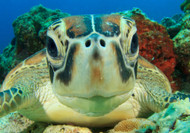10 Fun Facts About Hawaiian Green Sea Turtles
Posted by Maris on 16th Nov 2023
Chelonia mydas is the scientific name for the green sea turtle, while the Hawaiian name is just "Honu." These interesting marine reptiles are often the highlight of a good snorkeling trip for many people. Despite their endangered classification, sightings among the coral reefs in Hawaii seas are very regular. You have a decent chance of seeing one if you join us on a Molokini snorkel tour or a Lanai snorkel tour. Here are some of our favorite amusing facts about Honu, Hawaii's beloved green sea turtles.

1, Sea turtles cannot retract their heads into their shells unlike their freshwater counterparts.
2. The Honu's name is not derived from the color of its shell, which is frequently brown, grey, black, or dark olive. Its name comes from the color of its skin, or more precisely, subdermal (below the skin) body fat.
3. Adult Honu are herbivores with serrated teeth that feed seagrasses and algae, but youngsters are omnivores that eat insects, crabs, worms, sea grasses, and a variety of other food sources.
4. Honu can grow to be 3-4 feet tall and weigh up to 300-350 pounds or more!
5. This kind of turtle will not reach sexual maturity until they are between the ages of 20 and 50. They have been documented at ages ranging from 80 to 100 years. Scientists are continuously discovering their maturity and age range.

6. The carapace is a sea turtle's shell, and the plastron is the underside of the shell.
7. Honu can be found in warm subtropical and tropical ocean waters all around the world. Nesting has been observed in over 80 different countries. They nest in Hawaii, Puerto Rico, the Virgin Islands, and the east coast of Florida in the United States.
8. Honu habitats are divided between land and sea. The land is where they nest, lay eggs, and hatch, whereas the ocean is where they spend the vast bulk of their life. Because hatchlings seldom survive to reproductive age, the majority of them only contact land once in their life, on their way from their nest to the ocean.

9. Honu have been observed traveling considerable distances to return to their favorite breeding location. Across entire oceans, at times. When the ladies are ready to deposit their eggs, they climb up onto the sand, so if you see them emerge from the sea, give them lots of space.
10. The Honu's major predators are huge sharks, particularly tiger sharks. Entanglement in fishing gear, poaching, plastic ingestion, ocean pollution, and coastal development are all examples of human involvement. Respect and awareness can go a long way toward protecting the amazing Honu.


